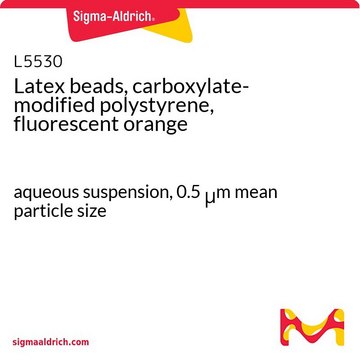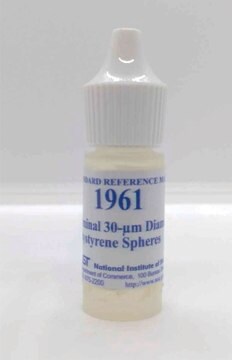LB8
Latex beads, polystyrene
0.8 μm mean particle size
Sinônimo(s):
Latex Beads, Latex Microspheres
Faça loginpara ver os preços organizacionais e de contrato
About This Item
Produtos recomendados
Formulário
aqueous suspension
composição
Solids, 10%
embalagem
pack of 1 mL
pack of 15 mL
pack of 2 mL
tamanho médio de partícula
0.8 μm
Procurando produtos similares? Visita Guia de comparação de produtos
Descrição geral
Polystyrene microparticles are stabilizedcolloidal particles that possess a negative charge and are synthesized by thepolymerization of styrene under conditions that induce spontaneous coalescentbead formation. Due to their versatility, these beads can be used in antibody-mediatedagglutination diagnostics, electron microscopy, cell counter calibration, andphagocytosis experiments.
Aplicação
Polystyrene latex beads have been used:
- inthe flow cytometric assay of endothelial microparticles (EMPs)
- in thedetection of capsular polysaccharide (CPS) antibody/antigen latex agglutinationtest
- to evaluate the phagocytic activity in hemocytes of shrimps
Código de classe de armazenamento
12 - Non Combustible Liquids
Classe de risco de água (WGK)
WGK 3
Ponto de fulgor (°F)
Not applicable
Ponto de fulgor (°C)
Not applicable
Escolha uma das versões mais recentes:
Já possui este produto?
Encontre a documentação dos produtos que você adquiriu recentemente na biblioteca de documentos.
Os clientes também visualizaram
Effects of traditional medical herbs ?minor bupleurum decoction? on the non-specific immune responses of white shrimp (Litopenaeus vannamei)
Yu-Sheng, et al.
Fish & Shellfish Immunology, 218-225, 84(1-842) (2017)
Joanna Koziel et al.
PloS one, 4(4), e5210-e5210 (2009-04-22)
It is becoming increasingly apparent that Staphylococcus aureus are able to survive engulfment by macrophages, and that the intracellular environment of these host cells, which is essential to innate host defenses against invading microorganisms, may in fact provide a refuge
Je-Wen Liou et al.
PloS one, 6(5), e19982-e19982 (2011-05-19)
Recent research shows that visible-light responsive photocatalysts have potential usage in antimicrobial applications. However, the dynamic changes in the damage to photocatalyzed bacteria remain unclear. Facilitated by atomic force microscopy, this study analyzes the visible-light driven photocatalyst-mediated damage of Escherichia
Nossa equipe de cientistas tem experiência em todas as áreas de pesquisa, incluindo Life Sciences, ciência de materiais, síntese química, cromatografia, química analítica e muitas outras.
Entre em contato com a assistência técnica









